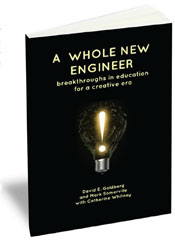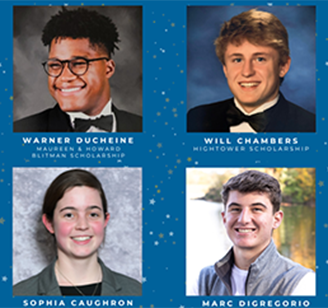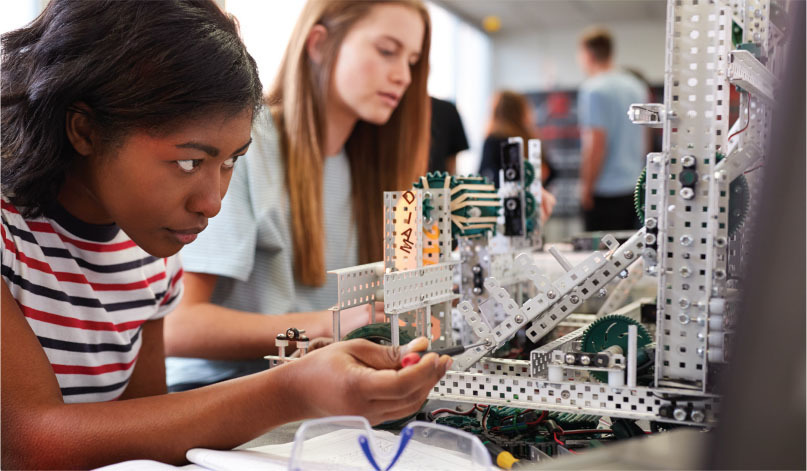June 2014
COMMUNITIES: EDUCATION
Why Engineering Education Needs to Change
An upcoming book from two educators puts a new spin on the much-discussed need for engineering education reform.
A Whole New Engineer, described as a joint memoir of transformation efforts at Olin College and the University of Illinois, argues that “engineering education has failed because it has been working on the wrong stuff.”
Authors Dave Goldberg, the Jerry S. Dobrovolny distinguished professor in entrepreneurial engineering emeritus at the University of Illinois at Urbana-Champaign, and Mark Somerville, professor of electrical engineering and physics at Olin College, admit that their ideas may seem odd to some. The time is right, however, for the right kind innovation, they say.
Goldberg recently shared his thoughts on the challenges, the origin of those challenges, and what needs to change.
PE magazine: What’s your view on the progress that has been made so far in engineering education reform?
Goldberg: With the coming of the Internet, engineering education has been working feverishly to remake itself, and certainly over the last decade or so good progress has been made in reinjecting design in the freshmen and senior years at many schools. But we still have math and science courses—what I have called the math-science death march—whose main purpose is to discard otherwise able students from the pipeline. And this frustrates STEM teachers in middle and high schools. They work like the devil to get kids into the pipeline, and engineering school works just as hard to kick them out. We have a process that, in many ways, delights in rejecting people from the path of being an engineer. And whether intended or not, the effect of this culture falls disproportionately on women and underrepresented minorities.
PE magazine: What are the root causes?
Goldberg: First, engineering education was much more practical and hands-on before World War II. After World War II, developments such as radar and the atomic bomb were credited to science and mathematics, even though engineering played a huge role in those particular efforts and the war effort generally. These narrowly technical subjects were elevated; more practical subjects were diminished, and increasingly engineers demonstrated their mettle in these subjects. Prior to the war, engineering was heavily influenced by the training of military officers in early military service academies, and their tradition of rigorous drill and training was used as a model.
PE magazine: What do you propose?
Goldberg: The first thing to notice is that we are talking about culture here, not science. The teaching of science and mathematics is a cultural practice. Weeding out the “unfit” is a cultural practice. Neither have scientific basis. We do them because we have done them. To be clear, I am not saying that we shouldn’t do them, but the first thing we recommend is noticing that to change engineering education is to change its culture. That engineering is not particularly inviting to women or to underrepresented minorities is a cultural phenomenon. To miss this is to work on the wrong problem. In quality manufacturing, we ask the five whys to get to root causes. When you ask the five whys in engineering education you get to culture.
 PE magazine: What else?
PE magazine: What else?
Goldberg: The next thing to notice is that in our process of weeding students out, ironically we do this before they even know what engineering is. We use math and science courses to discard engineering students, but real engineering coursework comes later. One of the big surprises in writing A Whole New Engineer was how powerful student passion becomes when it is used to ground the study of engineering. At Olin and Illinois, we asked students why they chose engineering. Then, we respected their answers and guided their education in service to these motives. In response, the students moved mountains to learn. In a word, starting from student emotional drives and trusting students led to students being unleashed in service to their education. Time and time again we saw this, and time and time again it was amazing to see the energy unleashed in service to genuine learning.
The result of reframing education around emotion and culture is to educate a kind of courageous engineer, a lifelong learner who has curiosity and creativity to tackle the challenges of our time. This is an exciting prospect, and it starts by focusing on the right stuff, by focusing on culture and emotion as the drivers of engineering education.
Dave Goldberg is the founder and president of Big Beacon, a movement to transform engineering education. Read the Big Beacon manifesto and find out more about A Whole New Engineer at www.bigbeacon.org.


 Volunteering at NSPE is a great opportunity to grow your professional network and connect with other leaders in the field.
Volunteering at NSPE is a great opportunity to grow your professional network and connect with other leaders in the field. The National Society of Professional Engineers (NSPE) encourages you to explore the resources to cast your vote on election day:
The National Society of Professional Engineers (NSPE) encourages you to explore the resources to cast your vote on election day:



